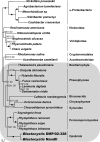Analysis of two genomes from the mitochondrion-like organelle of the intestinal parasite Blastocystis: complete sequences, gene content, and genome organization
- PMID: 18765437
- PMCID: PMC2568035
- DOI: 10.1093/molbev/msn193
Analysis of two genomes from the mitochondrion-like organelle of the intestinal parasite Blastocystis: complete sequences, gene content, and genome organization
Abstract
Acquisition of mitochondria by the ancestor of all living eukaryotes represented a crucial milestone in the evolution of the eukaryotic cell. Nevertheless, a number of anaerobic unicellular eukaryotes have secondarily discarded certain mitochondrial features, leading to modified organelles such as hydrogenosomes and mitosomes via degenerative evolution. These mitochondrion-derived organelles have lost many of the typical characteristics of aerobic mitochondria, including certain metabolic pathways, morphological traits, and, in most cases, the organellar genome. So far, the evolutionary pathway leading from aerobic mitochondria to anaerobic degenerate organelles has remained unclear due to the lack of examples representing intermediate stages. The human parasitic stramenopile Blastocystis is a rare example of an anaerobic eukaryote with organelles that have retained some mitochondrial characteristics, including a genome, whereas they lack others, such as cytochromes. Here we report the sequence and comparative analysis of the organellar genome from two different Blastocystis isolates as well as a comparison to other genomes from stramenopile mitochondria. Analysis of the characteristics displayed by the unique Blastocystis organelle genome gives us an insight into the initial evolutionary steps that may have led from mitochondria to hydrogenosomes and mitosomes.
Figures


References
-
- Abascal F, Zardoya R, Posada D. ProtTest: selection of best-fit models of protein evolution. Bioinformatics. 2005;21:2104–2105. - PubMed
-
- Adl SM, Simpson AGB, Farmer MA, et al. (28 co-authors) The new higher level classification of eukaryotes with emphasis on the taxonomy of protists. J Eukaryot Microbiol. 2005;52:399–451. - PubMed
-
- Boxma B, de Graaf RM, van der Staay GW, et al. (15 co-authors) An anaerobic mitochondrion that produces hydrogen. Nature. 2005;434:74–79. - PubMed
Publication types
MeSH terms
Substances
Grants and funding
LinkOut - more resources
Full Text Sources
Other Literature Sources

